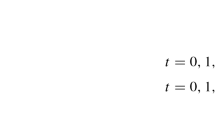Summary.
Boldrin and Montrucchio [2] showed that any twice continuously differentiable function could be obtained as the optimal policy function for some value of the discount parameter in a deterministic neoclassical growth model. I extend their result to the stochastic growth model with non-degenerate shocks to preferences or technology. This indicates that one can obtain complex dynamics endogenously in a wide variety of economic models, both under certainty and uncertainty. Further, this result motivates the analysis of convergence of adaptive learning mechanisms to rational expectations in economic models with (potentially) complicated dynamics.
Similar content being viewed by others
Author information
Authors and Affiliations
Additional information
Received: June 21, 1996; revised version: October 31, 1996
Rights and permissions
About this article
Cite this article
Mitra, K. On capital accumulation paths in a neoclassical stochastic growth model. Economic Theory 11, 457–464 (1998). https://doi.org/10.1007/s001990050197
Issue Date:
DOI: https://doi.org/10.1007/s001990050197




